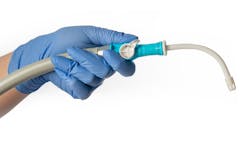Improve aerosol management with the new Dove Aero
SPONSORED ARTICLE
As dental practices reopened this summer, the Centers for Disease Control and Prevention advised us, “If aerosol-generating procedures are necessary for dental care, use four-handed dentistry, high-evacuation suction, and dental dams to minimize droplet spatter and aerosols. The number of [dental health-care professionals] present during the procedure should be limited to only those essential for patient care and procedure support.”1
With this new guidance, it has suddenly become critical for teams to find products that address the spread of contagions in evacuation, backflow, and aerosols.1 The Dove Aero from Dove Dental Products, released earlier this year, is one of the only products on the market that covers all three areas. This single-use hybrid device is designed to reduce aerosols produced by dental instruments while keeping patient comfort in mind. The Aero combines powerful high-volume evacuation (HVE) suction with a saliva ejector (SE) for one-way backflow protection. This easy-to-use device reduces airborne aerosol movement by as much as 95%.
The challenges with SE and HVE devices
Saliva ejectors are designed to remove fluid from inside patients’ mouths, and they do that pretty effectively. They’re able to easily access different areas of the mouth and won’t suck in patient tongues or cheeks, making the experience more comfortable. But the risk that comes with SEs, of course, is backflow. While you can tell patients not to close their lips around the tubing, there’s a good chance they’ll do it anyway. Because of this risk, SEs feature many small parts designed to prevent backflow, but these parts must be removed and cleaned thoroughly after every use.
HVEs, on the other hand, are quite powerful, sucking up everything in their path—including patients’ cheeks and tongues. So, while they offer great aerosol control, it’s a pretty unpleasant experience for your patients. And even though the HVE valve is bigger and carries less backflow risk than an SE, the potential is still there. Remember, everything is coming from the same suction line.
The best of both worlds
Dove set out to develop a product that overcomes these challenges. The new Dove Aero combines the best features of HVEs and SEs for a product that efficiently and comfortably collects aerosols without the risk of backflow, even when patients close their mouths. All of the company’s disposable HVE valves feature backflow flaps. And because it’s disposable, there’s no need to remove and clean small parts that can easily get lost or damaged.
Another challenge with HVE straws is patient access. Combining the company’s HVE valve with a shorter SE that’s easy to maneuver overcomes this challenge, getting hygienists closer to patients to collect aerosols. Even when working in the back of a patient’s mouth, hygienists can still achieve aerosol collection right at the lip line.
Easy use and integration
This first-of-its-kind valve offers external aerosol collection in the form of a tool hygienists are familiar with. The device is easy to connect and integrate into existing equipment, meaning there’s no need for complicated working positions, reducing discomfort for patients and hygienists. There’s also no need for large vacuums or gadgets that provoke gagging, another benefit for patients.
The saliva ejectors come secured on the valves in bags of 100 and cost about $2 each, making this an economical, easy way to manage aerosols and reduce cross contamination in your practice.
The benefits of disposables
Dove Aero is a single-use device, which means it should be used on only one patient during one procedure, according to the Food and Drug Administration.2 With concerns about COVID-19 making patients nervous about their dental appointments, it’s important to let them know what steps you’re taking to keep them safe. They’ll appreciate your efforts, and if they know you’re using products designed to keep them safe, they’ll be more likely to accept recommended treatment.
Evacuation valve study
Pat Pine, RDH, who’s been a hygienist for more than 30 years and speaks nationally and internationally about infection prevention, recently performed an informal case study on evacuation valves. She swab-tested the valves to determine if they remained contaminated after going through routine disinfection protocols.
The results were a little alarming. Pine completed the swab-testing herself and found most of the 212 valve surfaces were, in fact, still contaminated. Readings were taken at the beginning of the day or in-between patients with a Hygiena ATP Meter with packaged swabs. Contaminated valve surfaces can spread diseases, but this risk can be avoided with disposable devices such as the new Dove Aero.
Time for change
It’s critical for dental professionals to eliminate the risk of microbial cross contamination between patients. It always has been, but the COVID-19 pandemic has brought this issue into the spotlight. It’s time to update standard operating procedures and create checklists to ensure everything possible is being done to protect patients and team members.
Investing in the right products is key to safely practicing dentistry. The Dove Aero is designed to eliminate backflow and the disease transmission it can cause, as well as to effectively manage aerosols, keeping everyone in your practice safe from exposure to coronavirus. It’s comfortable, easy to use, and disposable, making it a must-have product in the fight against COVID-19.
Editor's note: This article is sponsored by Dove. Content has been reviewed for editorial integrity per RDH guidelines. For more information on our editorial standards, see rdhmag.com/page/submission-guidelines.
References
- Guidance for dental settings: Interim infection prevention and control guidance for dental settings during the COVID-19 response. Centers for Disease Control and Prevention. Updated August 28, 2020. https://www.cdc.gov/coronavirus/2019-ncov/hcp/dental-settings.html
- Single-use disposable devices. Centers for Disease Control and Prevention. https://www.cdc.gov/oralhealth/infectioncontrol/faqs/single-use-devices.html
Shannon Pace Brinker, CDA, is an international speaker, published author, and practicing dental assistant with more than 30 years’ experience. She has published numerous articles on clinical application and taught thousands of dental assistants across the US and Canada. Brinker has her own publication for dental assistants, From Our Side of The Chair. She started one of the first online platforms designated for dental assistants, the Academy of Chairside Assisting.
About the Author

Shannon Pace Brinker, CDA
Shannon Pace Brinker, CDA, is a national and international speaker, published author, and practicing dental assistant for over 30 years. She has published over 200 articles on clinical application and taught thousands of dental assistants across the US and Canada. She has her own publication for dental assistants, “From Our Side Of The Chair.” She has started one of the first online platforms designated for dental assistants called the Academy of Chairside Assisting.
